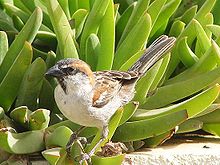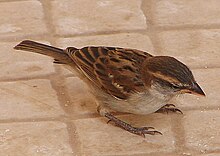Iago sparrow
| Iago sparrow | |
|---|---|
 |
|
 |
|
| Male (above) and female (below) on Sal | |
| Scientific classification | |
| Kingdom: | Animalia |
| Phylum: | Chordata |
| Class: | Aves |
| Order: | Passeriformes |
| Suborder: | Passeri |
| Family: | Passeridae |
| Genus: | Passer |
| Species: | P. iagoensis |
| Binomial name | |
|
Passer iagoensis (Gould, 1837) |
|
| Synonyms | |
|
Pyrgita iagoensis Gould, 1837 |
|
Pyrgita iagoensis Gould, 1837
Passer brancoensis Oustalet, 1883
Passer erthrophrys Temminck
The Iago sparrow (Passer iagoensis), also known as the Cape Verde or rufous-backed sparrow, is a passerine bird of the sparrow family Passeridae. It is endemic to the Cape Verde archipelago, in the eastern Atlantic Ocean near western Africa. Females and young birds have brown plumage with black marks above, and a dull grey underside, and are distinguished from other species of sparrow by their large, distinct supercilium. Males have a brighter underside and bold black and chestnut stripes on their head. At 12.5–13 centimetres (4.9–5.1 in) long, it is a smaller sparrow. This bird's vocalisations are mostly variations on its chirp, which differ somewhat between males and females.
The Iago sparrow was once thought to be most closely related to the rufous sparrows, a group of species within the genus Passer which live in similar habitats on continental Africa. Though the Iago sparrow is closest to the rufous sparrows in appearance, it has a number of crucial differences in morphology and behavior, and is separated by thousands of kilometres. It may in fact be more closely related to the house sparrow and Spanish sparrow. In Cape Verde it occurs on all but one island, and on most of them it is quite common. The Iago sparrow occurs in most habitats on available in its range, such as lava plains, rocky hills, and gorges; however, the house sparrow and Spanish sparrow are typically present instead in denser settlements and richer cultivated areas respectively. Because the Iago sparrow is not under any serious threats, it is assessed as Least Concern on the IUCN Red List.
The Iago sparrow is a small sparrow, 12.5–13 centimetres (4.9–5.1 in) long, with a wing length of 5.5–6.9 centimetres (2.2–2.7 in). Its plumage is similar to that of the house sparrow, and it similarly is sexually dimorphic. The male has a black or greyish-black crown and eyestripe, a grey nape and a small patch of white on the lower forehead. The sides of its head, especially above the eye, are a rich cinnamon colour. The scapulars are white and brown, while the rest of the upperparts are brown, streaked with black and beige. The cheeks and underparts are pale grey, and the throat and chin are marked with a small black bib. The female is grey-brown, with black-streaked wings and breast, and pale grey underparts. It is very similar to the female house sparrow but has a more apparent pale supercilium (stripe over the eye). The juvenile resembles the adult female, but young males are more chestnut from an early age, with a trace of a black bib on the chin. In 1898, ornithologist Boyd Alexander reported that adults begin moulting in early February, and some birds were still in moult by late May.
...
Wikipedia

